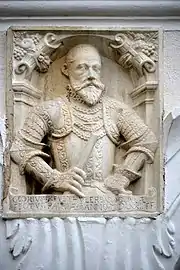George Khevenhüller
Georg von Khevenhüller (Croatian pronunciation: [juraj kevenxiler], also spelled as Gjuro or George Khevenhiller;[2] 22 April 1533 – 9 September 1587) was a Carinthian nobleman of the Khevenhüller dynasty.[3] Though a dedicated Protestant by faith, he served as a governor of the Catholic House of Habsburg for several decades. He is also famous for building the city-fortress of Karlovac in Croatia.
Georg von Khevenhüller | |
|---|---|
 Relief, Wernberg Castle | |
| Born | 22 April 1533 Pittersberg Castle, Kötschach, Carinthia |
| Died | 9 September 1587 (aged 54) Klagenfurt, Carinthia |
| Buried | Saint Jacob's Church, Villach |
| Noble family | Khevenhüller |
| Spouse(s) | Sibylla Weitmoser Anna von Thurzo[1] |
| Issue
Franz Christoph von Khevenhüller Maria von Khevenhuller | |
Life
The son of Sigmund Khevenhüller and nephew of the Carinthian governor (Landeshauptmann) Christoph von Khevenhüller (1503–1557), young George became a councillor at the court of the Habsburg emperor Ferdinand I and his successor Maximilian II. In 1565 he was appointed governor of Carinthia, later also President of the Inner Austrian Court Chamber at Graz and Court Chamberlain of Archduke Charles II of Austria. He distinguished himself as an officer in the Ottoman–Habsburg wars in the Kingdom of Croatia. On 21 August 1578, Khevenhiller and Ban Krsto Ungnad went from Slunj to Bihać.[4]
.jpg.webp)
In Croatia, Khevenhüller is remembered as a very cruel man.[5] From 1579 onwards, he had the City of Karlovac (Karlstadt), named in honour of Archduke Charles II,[6] built in order to strengthen the Habsburg southern defences against Ottoman encroaches.[7] The establishment of the new city was a part of the deal between the Protestant nobility of Inner Austria and the archduke: in exchange for their religious freedom the nobles agreed to finance the building of a new fortress against the Ottoman Empire. The six-pointed star fortress was built on the Zrinski estate near the old town of Dubovac at the confluence of the Kupa and Korana rivers, on terrain exposed to flooding and disease from unhealthy water, with the intent to hamper the Turkish advance.[8] Khevenhüller supervised work; he had gathered numerous serfs and forced them to build the new fortress.[9] The Croatian writer Miroslav Krleža (1893–1981) wrote a poem named after him[10] as part of his Ballads of Petrica Kerempuh, published in 1936.

In his later years, Khevenhüller again took his residence in Carinthia. By his two marriages, he could provide substantial financial resources to acquire the castles of Hochosterwitz and Wernberg by purchase;[11][12] he had both rebuilt in a lavish Renaissance style. In 1582 he had Annabichl Castle erected as a residence for his second wife Anna von Thurzo. He also supervised the redevelopment of Klagenfurt as the new Carinthian capital and had a city palace built in Villach about 1570, which however was destroyed in World War II.
Georg von Khevenhüller died in Klagenfurt; he is buried in the Saint Jacob's parish church of Villach alongside his uncle Christoph von Khevenhüller.
Family
George was a son of Katharina von Gleinitz zu Glenstätten and her husband Sigismund III Khevenhüller.[13]
He had two wives, Sibylla Weitmoser and Anna von Thurzo.[14]
His sister was Salome von Khevenhüller.
See also
References
- Anna Thurzo von Bethenfalva
- Reign Archived 2013-01-31 at the Wayback Machine of Rudolf II, Holy Roman Emperor
- Legacy of George Khevenhüller from 1576 carved on a marble plaque in the upper courtyard
- Povijest Hrvatske I. (R. Horvat)/Ban Krsto Ungnad at Croatian Wikisource. Please see this page.
- Siva boja smrti by Miroslav Vaupotić.
- Krležijana, Volume I, page 454.
- Radoslav Z. Lopašić: Karlovac, page 178.
- Treasures of Yugoslavia, published by Yugoslaviapublic, Beograd, available in English, German and Serbo-Croatian, 664 pages, 1980
- Evelyne Webernig: Der Landeshauptmann von Kärnten. Ein historisch-politischer Überblick. Verlag des Kärntner Landesarchivs, Klagenfurt 1987, ISBN 3-900531-18-8, S. 21–24.
- Književne interpretacije by Marin Franičević
- Joseph B. Hendrix: Through The Eye Of My Lens. "It has also remained in the possession of the Khevenhüller family as requested by the original builder, George Khevenhüller."
- Die Nationwerdung der Slowenen und die Reformation by Peter Bartl and Janez Rotar
- Sigismund III, Herr Khevenhüller in Hohen-Ostrewitz
- The Lineage and Ancestry of H.R.H. Prince Charles, Prince of Wales, by Gerald Paget, Vol. II, p. 111.